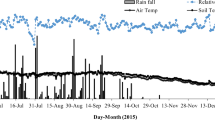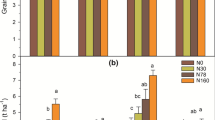Abstract
A field experiment was conducted on an acid sulfate soil in Thailand to determine the effect of N fertilization practices on the fate of fertilizer-N and yield of lowland rice (Oryza sativa L.). A delayed broadcast application of ammonium phosphate sulfate (16-20-0) or urea was compared with basal incorporation of urea, deep placement of urea as urea supergranules (USG), and amendment of urea with a urease inhibitor. Deep placement of urea as USG significantly reduced floodwater urea- and ammoniacal-N concentrations following N application but did not reduce N loss, as determined from an15N balance, in this experiment where runoff loss was prevented. The urease inhibitor, phenyl phosphorodiamidate (PPD), had little effect on floodwater urea- and ammoniacal-N, and it did not reduce N loss. The floodwater pH never exceeded 4.5 in the 7 days following the first N applications, and application of 16-20-0 reduced floodwater pH by 0.1 to 0.3 units below the no-N control. The low floodwater pH indicated that ammonia volatilization was unimportant for all the N fertilization practices. Floodwater ammoniacal-N concentrations following application of urea or 16-20-0 were greater on this Sulfic Tropaquept than on an Andaqueptic Haplaquoll with near neutral pH and alkaline floodwater. The prolonged, high floodwater N concentrations on this Sulfic Tropaquept suggested that runoff loss of applied N might be a potentially serious problem when heavy rainfall or poor water control follow N fertilization. The unaccounted-for15N in the15N balances, which presumably represented gaseous N losses, ranged from 20 to 26% of the applied N and was unaffected by urea fertilization practice. Grain yield and N uptake were significantly increased with applied N, but grain yield was not significantly affected by urea fertilization practice. Yield was significantly lower (P = 0.05) for 16-20-0 than for urea; however, this difference in yield might be due to later application of P and hence delayed availability of P in the 16-20-0 treatment.
Similar content being viewed by others
References
Allison FE (1963) Losses of gaseous nitrogen from soils by chemical mechanisms involving nitrous acid and nitrites. Soil Sci 96: 404–409
Austin ER, Bradford TJ and Lupin MS (1984) High-performance liquid chromatographic determination and hydrolysis studies of phenyl phosphorodiamidate, a urease inhibitor. J Agricultural Food Chemistry 32: 1090–1095
Buresh RJ (1987) Relative susceptibility of conventional and experimental nitrogen sources to ammonia loss from flooded rice fields. Fert Res 13: 139–153
Buresh RJ, Austin ER and Craswell ET (1982) Analytical methods in15N research. Fert Res 3: 37–62
Buresh RJ, De Datta SK, Padilla JL and Samson MI (1988) Effect of two urease inhibitors on floodwater ammonia following urea application to lowland rice. Soil Sci Soc Am J 52 (In press)
Cao ZH, De Datta SK and Fillery IRP (1983) Effect of placement methods on floodwater properties and recovery of applied N (15N-labeled urea) in wetland rice. Soil Sci Soc Am J 48: 196–203
Chairoj P, Uehara Y, Kimura M, Wada H and Takai Y (1984) Nitrogen dynamics in the uppermost part of submerged paddy soils in temeprate and tropical regions. Soil Sci Plant Nutr 30: 383–396
Craswell ET, De Datta SK, Obcemea WN and Hartantyo M (1981) Time and mode of nitrogen fertilizer application to tropical wetland rice. Fert Res 2: 247–259
Da Silva PRF and Stutte CA (1981) Nitrogen loss in conjunction with transpiration from rice leaves as influenced by growth stage, leaf position, and N supply. Agron J 73: 38–42
De Datta SK, Obcemea WN, Chen RY, Calabio JC and Evangelista RC (1987) Effect of water depth on nitrogen use efficiency and nitrogen-15 balance in lowland rice. Agron J 79: 210–216
Douglas LA and Bremner JM (1970) Extraction and colorimetric determination of urea in soils. Soil Sci Soc Am Proc 34: 859–862
Fillery IRP, Simpson JR and De Datta SK (1984) Influence of field environment and fertilizer management on ammonia loss from flooded rice. Soil Sci Soc Am J 48: 914–920
Fillery IRP and De Datta SK (1986) Ammonia volatilization from nitrogen sources applied to rice fields: I. Methodology, ammonia fluxes, and nitrogen-15 loss. Soil Sci Soc Am J 50: 80–86
Freney JR, Simpson JR and Denmead OT (1983) Volatilization of ammonia. In: Freney JR and Simpson JR (eds.) Gaseous loss of nitrogen from plant-soil systems, Martinus Nijhoff, The Hague, pp 1–32
IAEA (1978) Isotope studies on rice fertilization. IAEA Technical Report Series 181, Vienna
IFDC (1985) Asia fertilizer situation. International Fertilizer Development Center, Muscle Shoals, AL
IRRI (1982) Annual report for 1981. International Rice Research Institute, Los Baños, Laguna, Philippines
Kanareugsa C, Mamaril CP and De Datta SK (1987) Country report: Thailand. In: Efficiency of nitrogen fertilizers for rice. International Rice Research Institute, Los Baños, Laguna, Philippines, pp 253–257
Katyal JC, Singh Bijay, Vlek PLG and Craswell ET (1985) Fate and efficiency of nitrogen fertilizers applied to wetland rice. II. Punjab, India. Fert Res 6: 279–290
Moller Nielsen J, Mural NS, Bauphan C, Poovarodom S, Lawongsa P and Alva AK (1986) Fertilization of tropical rice: a case study on Bangkok plain. Fert Res 10: 97–112
Neue HU, Scharpenseel HW and Martin U (1983) Kurzmitteilung ammoniak-abgabe durch blatter von reispflanzen. Z Pflanzenernaehr Bodenk 146: 398–400
Phongpan S (1985) Volatilization losses of ammonia from flooded soils: I. Effects of nitrogen source, method of placement and soil type. Thai J Agric Sci 18: 109–122
Singh BK, Tan PS, Thanh LV and Luat NV (1987) Phosphorus application to acid-sulfate soil. International Rice Research Newsletter 12 (3): 51–52
Sorasith V and Takai Y (1983) Paddy nitrogen economy: Comparative ecological study on nitrogen economy of paddy soil between tropical and temperate regions. NODAI Research Institute, Tokyo University of Agriculture
Van Breemen N (1976) Genesis and solution chemistry of acid sulfate soils in Thailand. Agric Res Rep (Versl Landbouwkd Onderz) 848, PUDOC, Wageningen, Netherlands
Van Breemen N and Pons LJ (1978) Acid sulfate soils and rice. In: Soils and rice. International Rice Research Institute, Los Baños, Laguna, Philippines, p 739–761
Verdouw H, van Echteld CJA and Dekkers EMJ (1978) Ammonia determination based on indophenol formation with sodium salicylate. Water Research 12: 399–402
Vlek PLG and Byrnes BH (1986) The efficacy and loss of fertilizer N in lowland rice. Fert Res 9: 131–147
Wetselaar R and Farquhar GD (1980) Nitrogen losses from tops of plants. Adv Agron 33: 263–302
Author information
Authors and Affiliations
Rights and permissions
About this article
Cite this article
Snitwongse, P., Satrusajang, A. & Buresh, R.J. Fate of nitrogen fertilizer applied to lowland rice on a Sulfic Tropaquept. Fertilizer Research 16, 227–240 (1988). https://doi.org/10.1007/BF01051373
Accepted:
Issue Date:
DOI: https://doi.org/10.1007/BF01051373




